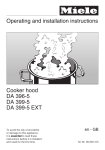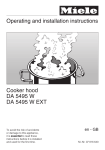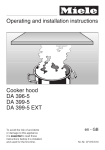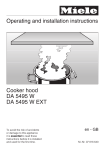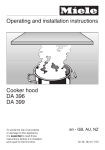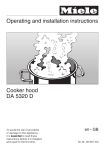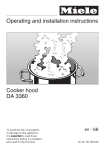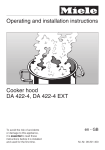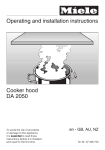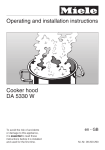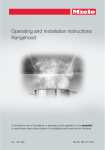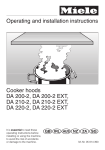Download Miele H 186 MB Technical data
Transcript
Operating and installation instructions Cooker hood DA 186 To avoid the risk of accidents or damage to this appliance, it is essential to read these instructions before it is installed and used for the first time. en - GB M.-Nr. 07 623 170 Contents Caring for the environment . . . . . . . . . . . . . . . . . . . . . . . . . . . . . . . . . . . . . . . . . . 3 Warning and Safety instructions . . . . . . . . . . . . . . . . . . . . . . . . . . . . . . . . . . . . . 4 Modes of operation . . . . . . . . . . . . . . . . . . . . . . . . . . . . . . . . . . . . . . . . . . . . . . . . 9 Guide to the appliance / Operation . . . . . . . . . . . . . . . . . . . . . . . . . . . . . . . . . . 10 Operation . . . . . . . . . . . . . . . . . . . . . . . . . . . . . . . . . . . . . . . . . . . . . . . . . . . . . . . . 11 Cleaning and care . . . . . . . . . . . . . . . . . . . . . . . . . . . . . . . . . . . . . . . . . . . . . . . . 12 Housing . . . . . . . . . . . . . . . . . . . . . . . . . . . . . . . . . . . . . . . . . . . . . . . . . . . . . . . . . 12 Grease filters . . . . . . . . . . . . . . . . . . . . . . . . . . . . . . . . . . . . . . . . . . . . . . . . . . . . . 13 Charcoal filters . . . . . . . . . . . . . . . . . . . . . . . . . . . . . . . . . . . . . . . . . . . . . . . . . . . . 14 Changing a halogen lamp . . . . . . . . . . . . . . . . . . . . . . . . . . . . . . . . . . . . . . . . . . . 15 After sales service . . . . . . . . . . . . . . . . . . . . . . . . . . . . . . . . . . . . . . . . . . . . . . . . 16 Appliance dimensions . . . . . . . . . . . . . . . . . . . . . . . . . . . . . . . . . . . . . . . . . . . . . 17 Safety distance between hob and cooker hood. . . . . . . . . . . . . . . . . . . . . . . . 17 Installation . . . . . . . . . . . . . . . . . . . . . . . . . . . . . . . . . . . . . . . . . . . . . . . . . . . . . . 18 Electrical connection . . . . . . . . . . . . . . . . . . . . . . . . . . . . . . . . . . . . . . . . . . . . . 23 Connection for air extraction . . . . . . . . . . . . . . . . . . . . . . . . . . . . . . . . . . . . . . . 24 Technical data . . . . . . . . . . . . . . . . . . . . . . . . . . . . . . . . . . . . . . . . . . . . . . . . . . . 25 2 Caring for the environment Disposal of the packing material Disposal of your old appliance The transport and protective packing has been selected from materials which are environmentally friendly for disposal, and should be recycled. Electrical and electronic appliances often contain materials which, if handled or disposed of incorrectly, could be potentially hazardous to human health and to the environment. They are, however, essential for the correct functioning of your appliance. Please do not therefore dispose of it with your household waste. Packaging e.g. cling film, polystyrene and plastic wrappings must be kept out of the reach of babies and young children. Danger of suffocation! Please dispose of it at your local community waste collection / recycling centre or contact your dealer for advice. Ensure that it presents no danger to children while being stored for disposal. 3 Warning and Safety instructions This appliance complies with all relevant local and national safety requirements. Inappropriate use can, however, lead to personal injury and damage to property. To avoid the risk of accidents and damage to the appliance, please read these instructions carefully before using it for the first time. They contain important information on the safety, installation, use and maintenance of the appliance. Keep these instructions in a safe place and ensure that all users are familiar with the contents. Pass them on to any future owner of the appliance. Correct application ~ This appliance is intended for use in domestic households and in similar working and residential environments such as: – Shops – Offices and showrooms and by residents in establishments such as: – Hostels and guest houses. ~ It must only be used as a domestic appliance to extract vapours and remove odours from cooking. 4 ~ The cooker hood is not intended for outdoor use. Any other usage is not supported by the manufacturer and could be dangerous. Miele cannot be held liable for damage resulting from incorrect or improper use or operation. ~ This appliance is not intended for use by people with reduced physical, sensory or mental capabilities, or lack of experience or knowledge, unless they are supervised whilst using it or have been shown how to use it correctly by a person responsible for their safety. Safety with children ~ This appliance is only intended for use by adults who have read these instructions. ~ This appliance is not a toy! To prevent the risk of injury do not let children play with the appliance or its controls. ~ Children under 8 years of age must be kept away from the cooker hood unless they are constantly supervised. ~ Children 8 years and older may use the cooker hood only if they have been shown how to use it in a safe way and understand the hazards involved. ~ Please be aware that on cooker hoods with halogen lighting, the lamps will get very hot during use and remain hot for some time after switching off. To safeguard against burning, keep children well away from the lamps at all times. Warning and Safety instructions Technical safety ~ Before installation, check the cooker hood for visible signs of damage. Under no circumstances should you use a damaged appliance. A damaged appliance is dangerous. ~ Before connecting the appliance to the mains supply, make sure that the voltage and frequency details given on the data plate correspond with the on-site electricity supply, otherwise the appliance could be damaged. Consult a qualified electrician if in any doubt. ~ The electrical safety of this appliance can only be guaranteed when continuity is complete between the appliance and an effective earthing system which complies with current local and national safety regulations. It is most important that this basic safety requirement is present and tested regularly, and where there is any doubt, the household wiring system should be inspected by a qualified electrician. The manufacturer cannot be held liable for the consequences of an inadequate earthing system (e.g. electric shock). ~ Installation, maintenance and repairs may only be carried out by a Miele authorised person in accordance with current national and local safety regulations. Repairs and other work by unqualified persons could be dangerous. The manufacturer cannot be held liable for unauthorised work. ~ A damaged connection cable must only be replaced by an approved and suitably qualified technician. ~ Faulty components must only be replaced by genuine Miele original parts. The manufacturer can only guarantee the safety of the appliance when Miele replacement parts are used. ~ During installation, maintenance and repair work, the appliance must be disconnected from the mains electricity supply. ~ For safety reasons, this appliance may only be used when it has been fully installed. ~ Only open the housing as described in the instructions given in the installation sheet and in the Cleaning and care section of this booklet. Under no circumstances should any other parts of the housing be opened. Tampering with electrical connections or components and mechanical parts is highly dangerous to the user, and can cause operational faults. 5 Warning and Safety instructions ~ Do not connect the appliance to the mains electricity supply by a multi-socket unit or an extension lead. These do not guarantee the required safety of the appliance (e.g. danger of overheating). Using at the same time as other heating appliances that depend on the air from the room Warning - danger of toxic fumes ~ This appliance must not be used in a non-stationary location (e.g. on a ship). ~ In countries where there are areas which may be subject to infestation by cockroaches or other vermin, pay particular attention to keeping the appliance and its surroundings in a clean condition at all times. Any damage which may be caused by cockroaches or other vermin will not be covered by the guarantee. ~ Great care should be taken when using the cooker hood at the same time and in the same room or area of the house as another heating appliance which depends on the air in the room. Such appliances include gas, oil, wood or coal-fired boilers and heaters, continuous flow or other water heaters, gas hobs, cookers or ovens which draw air in from the room and duct exhaust gases out through a chimney or extraction ducting. When used in extraction mode, the appliance draws air in from the room in which it is installed and from neighbouring rooms. If there is insufficient air, an underpressure will occur. The heating appliance may be starved of oxygen, impairing combustion. Harmful gases could be drawn out of the chimney or extraction ducting back into the room, with potentially fatal consequences. 6 Warning and Safety instructions In order to ensure safe operation, and to prevent gases given off by the heating appliances from being drawn back into the room when the cooker hood and the heater are in operation simultaneously, an underpressure in the room of 0.04 mbar (4 pa) is the maximum permissible. Correct use ~ Never use an open flame beneath the cooker hood. To avoid the danger of fire, do not flambé or grill over an open flame. When switched on, the cooker hood could draw flames into the filter. Fat particles drawn into the cooker hood present a fire hazard. ~ When using the cooker hood over a Ventilation can be maintained by air inlets which cannot be blocked, in windows, doors and outside wall vents, or by other technical measures, such as ensuring that the cooker hood can only be switched on when the heating appliance is switched off or vice versa. A ventilation brick alone is not generally sufficient to ensure safe ventilation. ,The overall ventilation condition of the dwelling must be taken into account. If in any doubt, the advice of a competent builder or, for gas, a "Corgi" installer, must be sought. gas hob, ensure that any burners in use are always covered by a pan. Switch the cooking zone off when a pan is removed, even for a short time. Regulate the flame so that it does not burn up the sides of the pan. Do not allow the pans to overheat excessively (e.g. when using a wok). The cooker hood can become damaged when exposed to excessive heat. ~ Always switch the cooker hood on when a cooking zone is in use, otherwise condensation may collect in the hood, which could cause corrosion. ~ When cooking with oil or fat, chip pans and deep fat fryers etc, do not leave the pans unattended. Never leave an open grill unattended when grilling. Overheated oil and fat can ignite and could set the cooker hood on fire. If the hood is being operated in recirculation mode, the above restrictions do not apply. 7 Warning and Safety instructions ~ Do not use the cooker hood without the filters in place. This way you will avoid the risk of grease and dirt getting into the appliance and hindering its smooth operation. ~ The filters should be regularly cleaned or changed as appropriate. Saturated filters are a fire hazard. See "Cleaning and care". ~ Do not use a steam-cleaner to clean this appliance. Pressurised steam could reach the electrical components and cause a short circuit. Correct installation ~ Refer to the cooker or hob manufacturer's instructions as to whether a cooker hood may be operated above the cooker/hob. ~ The minimum safety distances between the top of the cooker or hob and the bottom of the cooker hood given in the "Appliance dimensions" section of this booklet must be maintained, unless the hob manufacturer states that a greater safety distance is required. If more than one cooking appliance is fitted beneath the cooker hood, and they have different minimum safety distances to the cooker hood, select the greater distance. Follow the cooker or hob manufacturer's instructions on the use of flammable materials over the cooker/hob when installing a wood or laminate decor panel onto the cooker hood. 8 ~ Safety regulations prohibit the fitting of a cooker hood over solid fuel stoves. ~ All ducting, pipework and fittings must be of non-flammable material. These can be obtained from the Miele Spare Parts department or from builders' merchants. ~ The appliance must not be connected to a chimney or vent flue which is in use. Neither should it be connected to ducting which ventilates rooms with fireplaces. ~ If exhaust air is to be extracted into a chimney or ventilation duct no longer used for other purposes, seek professional advice. Accessories ~ Only use genuine Miele spare parts and accessories with this appliance. If spare parts or accessories from other manufacturers are used, this will invalidate the guarantee, and Miele cannot accept liability. The manufacturer cannot be held liable for damage caused by non-compliance with these Warning and Safety instructions. Modes of operation The cooker hood works with . . . air extraction: . . . air recirculation: The air is drawn in and cleaned by the grease filters and directed outside. The air is drawn in and cleaned first by the grease filters and then by two charcoal filters. If the on-site ventilation system does not have a non-return flap, the non-return flap supplied must be fitted. This flap is closed when the cooker hood is switched off. No exchange of room and outside air can take place. When the cooker hood is switched on, the non-return flap opens for the cooking vapours to be blown directly outside. The cleaned air is then recirculated back into the kitchen through a vent in the top of the cooker hood. The charcoal filters are available to order through your Dealer or the Miele Spare Parts Dept (see back page for contact details and Technical data for part number). Before using the cooker hood in recirculation mode, ensure that the charcoal filters are in place. See Cleaning and care. 9 Guide to the appliance / Operation 10 Guide to the appliance / Operation a Recirculation grille (only for recirculation mode) b Exhaust connection c Adjustable bracket d Vapour canopy to which a furniture door front is fitted e Charcoal filter (extra accessory available to order for recirculation mode) f Hob lighting g Grease filters h Control panel Operation To switch on the fan ^ Open the vapour canopy. The fan will come on at power level 2. It is advisable to run the fan for a few minutes after cooking has finished to neutralise any lingering odours in the air, whether you are using air extraction or recirculation mode. ^ To switch the fan off – close the vapour canopy, or – press the OFF button for longer. To switch on the lighting ^ The lighting comes on when the vapour canopy is opened up and switches off when the canopy is closed. In the event of a power cut, the fan and the lighting will switch off automatically. Once power has been restored to the appliance, the fan will come on at power level 2 and the lighting will switch on again when the vapour canopy is opened. ^ Press the appropriate buttons to select the power level required. Depending on the intensity of the cooking vapours, levels 1-3 are usually sufficient for normal cooking. Intensive setting For short periods of cooking food with intensive vapours and a strong aroma, e.g. when searing meat, you may wish to select the Intensive Setting "IS". The cooker hood will automatically revert to the previously selected power level after 10 minutes. 11 Cleaning and care A range of Miele branded cleaning and conditioning products is available to order from Miele (see back page for details) or via the internet at www.miele-shop.com. ,Before carrying out any cleaning or maintenance work, disconnect the cooker hood from the mains supply. ,Halogen lamps get very hot during use and remain hot for some time after being switched off. The hot lamps are also susceptible to damage from damp cleaning. Wait a few minutes after switching off before commencing cleaning. Housing The surfaces and controls are susceptible to scratches and abrasions. Please observe the following cleaning instructions. All external surfaces and controls can be cleaned using warm water with a little washing-up liquid applied with a well wrung-out soft sponge or cloth. Wipe the surfaces dry using a soft cloth. Do not use too much water when cleaning the controls. Water could penetrate into the electronics and cause damage. 12 Avoid: – cleaning agents containing soda, acids, chlorides or solvents, – abrasive cleaning agents, e.g. powder cleaners or cream cleaners and abrasive sponges, as well as pot scourers or sponges which have been used previously with abrasive cleaning agents. These will damage the surface material. A microfibre "E-Cloth" is available from the Miele UK Spare Parts Department, which is suitable for cleaning surfaces such as stainless steel, glass, plastic and chrome without the use of chemicals. Cleaning and care Grease filters Do not use: The re-usable metal grease filters in the appliance remove solid particles (grease, dust, etc.) from the kitchen vapours, preventing soiling of the cooker hood. – neat washing-up liquid, They should be cleaned at least every 3-4 weeks to avoid grease sticking hard to them. ,An oversaturated filter is a fire hazard. – cleaning agents containing descaling agents, – powder cleaners, cream cleaners or abrasive all-purpose cleaning agents, – oven sprays. Cleaning the grease filters in the dishwasher ^ Place the filters as upright as possible in the lower basket, with the short sides upright, and wash on a 65°C programme, ensuring the spray arm is not obstructed. If a Miele dishwasher is being used, select the Sensor wash programme. ^ Use a mild dishwasher detergent. ^ Release the locking clips on the grease filters, and carefully lower and remove the filters. To avoid damaging the filters or the hob below, make sure you hold the filters securely at all times when handling them. Cleaning the grease filters by hand ^ Clean the filters with a soft nylon brush in a mild solution of hot water and a little washing-up liquid. Depending on the cleaning agent used, cleaning the grease filters in a dishwasher can cause permanent discolouration to the surface of the filters. However, this will not affect the functioning of the grease filters in any way. ^ After cleaning, leave the filters to dry on an absorbent surface before replacing them. ^ When removing the filters for cleaning also clean off any residues of oil or fat from the now accessible housing to prevent the risk of these catching fire. 13 Cleaning and care Charcoal filters If the cooker hood is being used on recirculation mode, two DKF 14-1 charcoal filters must be fitted behind the grease filters. Important: For better access, the vapour canopy can be removed completely. ^ Open the vapour canopy ^ Open the vapour canopy ^ Remove the grease filters. ^ Unwrap the charcoal filters. ^ Push down on the sliding catch to release the vapour canopy, and lift it out. ^ Position the charcoal filters on either side of the fan as shown, and twist securely into place. ^ Replace the grease filters. The charcoal filters should be replaced when they are no longer functioning efficiently, or at least every six months. 14 ^ To replace the vapour canopy, re-fit it into the guides at the top and lower it into place. Cleaning and care Changing a halogen lamp ,Before any cleaning or maintenance work, disconnect the cooker hood from the mains supply. ,Exercise caution when changing halogen lamps. They get very hot during use, and remain hot for some time after being switched off. Do not touch the surface directly when changing a lamp, as grease particles from your fingers will adhere to the surface and damage it. Please follow the manufacturer’s instructions. ^ Unscrew the two fixing screws on the lamp holder. ^ Remove the lamp unit. ^ Push the halogen lamp out of its mounting from the back. Take care not to let the halogen lamp fall onto the hob. ^ Fit a new halogen lamp (20 W) into the socket, and replace the lamp unit and the screws. 15 After sales service In the event of a fault which you cannot correct yourself, or if the appliance is under guarantee, please contact: – your Miele Dealer or – the Miele Service Department (see back cover for contact details). When contacting the Service Department, please quote the model and serial number of your appliance These are shown on the data plate which is visible when the grease filter is removed. Please note that telephone calls may be monitored and recorded for training purposes. 16 Guarantee For information on the appliance guarantee specific to your country please contact Miele. See back cover for contact details. In the U.K. your appliance is guaranteed for 2 years from the date of purchase. To activate your cover call 0845 365 6640 or register online at www.miele.co.uk Appliance dimensions * Furniture panel dimensions Connection for air extraction C 150 mm, or C 120 mm with reducing collar. Safety distance between hob and cooker hood The distance betwen the top of the cooker/hob and the bottom of the cooker hood must measure at least 650 mm, unless a greater distance is specified by the manufacturer. If this cooker hood is installed above a Miele Wok CS 1028 CombiSet appliance, a minimum safety distance of 760 mm must be maintained between the burner and the lower edge of the cooker hood. For further advice, see Warning and Safety instructions. 17 Installation Before installation, it is important to read the information given on the following pages as well as the Warning and Safety instructions at the beginning of this booklet. This is particularly crucial when using the cooker hood at the same time as a heating appliance that relies on oxygen from the same room, which could result in the build-up of toxic fumes. ^ Take the filter out and then remove the protective foil from around the filter frame. Fitting a furniture door front ^ Cut the drilling template for the furniture door front to size, place it on the inside of the door, and drill the holes as marked. ^ Open the vapour canopy ^ Pull forward the sliding catch to release the vapour canopy, and then lift the canopy out. 18 ^ Screw the furniture door front onto the vapour canopy. Installation Depth adjustment Fitting the cooker hood to the wall ^ Cut the drilling template for the wall fixings to size, and position against the wall. ^ The depth of the unit "T" can be adjusted from 275 to 360 mm by means of the adjustable brackets. ^ Slightly loosen the screws on the brackets. ^ Then pull the brackets out until you achieve the required depth "T". ^ Tighten the screws up again. ^ To align the depth on the underside of the appliance, loosen the screws on the angle plate and move it to the position required. ^ If this does not provide enough adjustment, unscrew the angle plate completely, turn it around and use the longer side. The top edge of the template indicates the top edge of the appliance. It must be at least H = 1100 mm in order to comply with the safety height required above a hob or cooker. ^ Mark and drill the four drill holes for the mounting plates (C 8 mm). ^ Fix the mounting plates to the wall using the S 8 rawlplugs and 4,5 x 45 mm screws supplied. A drilling template is provided if you wish to secure the cooker hood to adjoining wall units, or to fit side panels. ^ Using the template, drill two fixing holes in the side of the wall unit or the side panel (C 2 mm). ^ Tighten the screws up again. 19 Installation ^ Position the vapour canopy with the furniture door front fitted, and close it. ^ The recirculation grille must be removed when the hood is used in extraction mode. The movement of the vapour canopy can be adjusted if necessary, for instance where a heavy furniture door is fitted. The adjusting screws are accessed through openings on either side of the appliance. ^ Remove both cover caps. ^ Hang the cooker hood in position using the adjustable brackets. ^ Using a cross-slotted screwdriver adjust both sides evenly: - turn clockwise to tighten the mechanism, - turn anti-clockwise to loosen the mechanism ^ Then refit the cover caps. 20 Installation Height adjustment Securing the appliance to neighbouring wall units or fitting side panels ^ Remove the vapour canopy. ^ Remove the grease filters. ^ Using the screws at the back of the adjustable brackets, align the cooker hood height with that of neighbouring units. Turn the screw – clockwise : to lower the appliance. ^ Secure the cooker hood to the neighbouring units, or fit the side panels, using two screws each side. For the lower screws, first remove the screw caps, and refit them afterwards. ^ If necessary adjust the depth again. ^ Replace the vapour canopy. – anti-clockwise : to raise the appliance. 21 Installation With air extraction: If the on-site ventilation system does not have a non-return flap, one of the two non-return flaps supplied (for C 150 mm or C 120 mm ducting) must be fitted. ^ Finally refit the grease filters. – If C 150 mm ducting is being used, the non-return flap should be fitted onto the exhaust connection. With C 120 mm ducting, first fit the reducing collar supplied onto the exhaust connection and then fit the appropriate non-return flap into the reducing collar. ^ For extraction connection, secure a flexible ducting or an extraction pipe to the exhaust connection using a hose clip. ^ Proceed with the exhaust connection. (see "Connection for air extraction"). With recirculation mode: ^ Fit the charcoal filters (see "Cleaning and Care"). 22 Electrical connection All electrical work should be undertaken by a suitably qualified and competent person in strict accordance with current national and local safety regulations (BS 7671 in the UK). Installation, repairs and other work by unqualified persons could be dangerous, for which the manufacturer cannot be held liable. Ensure power is not supplied to the appliance until after installation or repair work has been carried out. Do not connect the appliance to the mains electricity supply by an extension lead. These do not guarantee the required safety of the appliance. The voltage and connected load are given on the data plate. This is visible when the grease filters have been removed. Ensure that these match the household mains supply. If the switch is not accessible after installation (depending on country), an additional means of disconnection must be provided for all poles. For extra safety it is advisable to install a residual current device (RCD) with a trip current of 30 mA. Important This appliance is supplied for connection to an a.c. 230 V single phase 50 Hz supply. The wires in the mains lead are coloured in accordance with the following code: Green/yellow = earth Blue = neutral Brown = live WARNING: THIS APPLIANCE MUST BE EARTHED Connection of this appliance should be made via a suitable isolator or a double pole fused spur connection unit which complies with national and local safety regulations and the On-Off switch should be easily accessible after the appliance has been built in. When switched off there must be an all-pole contact gap of 3 mm in the switch (including switch, fuses and relays according to EN 60 335). 23 Connection for air extraction Important: To avoid the danger of toxic fumes, please observe the Warning and Safety instructions. This is especially crucial when using the cooker hood at the same time as another heating appliance which relies on air from the same room. The cooker hood should be installed according to local and national building regulations. Seek approval from the building inspector where necessary. – Where ducting is horizontal, it must be laid to slope away at at least 1 cm per metre. This is to ensure that condensate cannot drain back into the cooker hood. – If the exhaust air is to be ducted into the open air, the installation of a telescopic wall vent is recommended. – All ducting, pipework and fittings must be of non-flammable materials. – The exhaust ducting should be as short and straight as possible. – To ensure efficient air extraction, the diameter of the exhaust ducting should not be less than 150 mm. If exhaust ducting with a diameter of less than 150 mm, or if flat ducting is used, the noise level of the cooker hood will increase and extraction will be less efficient. Only reduce the diameter of the ducting if absolutely necessary, e.g. where narrower ducting has already been installed. – Only use wide radius bends. Tight bends reduce the air throughput of the cooker hood. – Only use smooth pipes or flexible hoses made from non-flammable materials for extraction connection. 24 – If the exhaust air is to be ducted into a vent flue, the ducting must be directed in the flow direction of the flue. Important: If the exhaust ducting is to run through rooms, ceiling space etc. where there may be great variations in temperature between the different areas, the problem of condensation will need to be addressed. The exhaust ducting will need to be suitably insulated. Technical data Total connected load. . . . . . . . . . 175 W Fan motor . . . . . . . . . . . . . . . . . 135 W Hob lighting . . . . . . . . . . . . . . 2 x 20 W Voltage . . . . . . . . . . . . . . . . . AC 230 V Frequency. . . . . . . . . . . . . . . . . ~ 50 Hz Fuse rating (UK) . . . . . . . . . . . . . . . . 5 A Electrical cable length . . . . . . . . . 1.8 m Fan performance Extraction power according to EN 61591 Extraction system C 150 mm: Level I . . . . . . . . . . . . . . . . . . . 200 m3/h Level II. . . . . . . . . . . . . . . . . . . 300 m3/h Level III . . . . . . . . . . . . . . . . . . 400 m3/h Intensive Setting . . . . . . . . . . . 560 m3/h Recirculation with charcoal filter: Level I . . . . . . . . . . . . . . . . . . . 100 m3/h Level II. . . . . . . . . . . . . . . . . . . 150 m3/h Level III . . . . . . . . . . . . . . . . . . 200 m3/h Level IV Intensive Setting . . . . 250 m3/h With recirculation mode: 2 Miele charcoal filters DKF 14-1 25 26 27 Alteration rights reserved / 3011 M.-Nr. 07 623 170 / 03




























